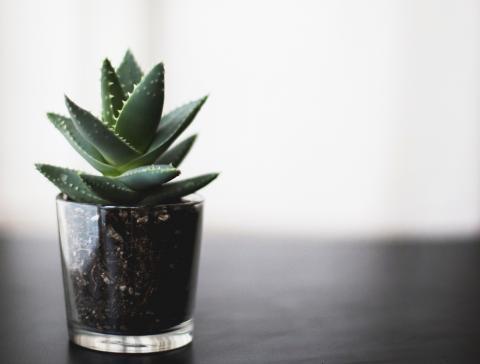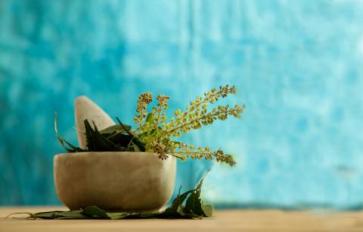
Succulents have received a lot of attention lately, and with good reason—they can be easy to grow, bloom beautifully, and come in a variety of shapes and sizes. They’re also infinitely Instagrammable. If you’re looking to try your hand at succulents but aren’t sure where to start, consider these three. They’re three easy-to-grow succulents, sure to make even the laziest gardener or frequent traveler a successful grower of greenery. And no yard needed—they’ll all grow just as well indoors! (As with most plants, protect them from excessive frost if you do grow them outdoors.)
Haworthia
Haworthias, like most succulents, come in many different types—but they do all tend to have a certain “look” about them—specifically, lots of thick, spiny leaves. They can be really dark green or a light, almost neon green, and lots of colors in between. They’re slow growers that are perfect for miniature gardens or fairy landscapes, and they can thrive even in lowlight conditions; with the right care they can live in terrariums. In fact, too much direct, hot sunlight can actually burn them, although they do best with some bright but indirect light each day. Like all succulents, they need infrequent watering—but these can get by with even less than other succulents, like echeverias or sedums, which need more water. Just don’t overwater them! They don’t like soggy soil.

This is one of the lighter colored, fleshier haworthia species with thicker leaves.
Instead, they need well-draining soil, so keep that in mind when potting them. In fact, I like to plant mine in pure 100% pumice to keep things moving freely and give their roots plenty of room. Because their roots…are really one of my favorite things about them. They have the best roots! While the visible portion of haworthias might be slow growing, I’ve actually noticed their roots grow comparatively quickly to other plants. The first time I repotted one of my haworthias, I was startled to see what looked like little white, green-headed worms poking through the soil—they were new root growth! Keep this in mind if you plant them in a container with other plants, as their roots tend to take over the whole pot. (They can still grow with other plants, just be prepared to lose some roots when you repot them.)

Check out those gnarly roots!
If you are really concerned about your lack of a green thumb, stick to the darker, firmer, harder-skinned haworthias instead of the lighter green, softer-fleshed ones, or window leaf species. In my experience, the harder/pokier ones are more forgiving of neglect (or excessive attention). And be on the lookout for little babies sprouting off from them—pups will pop up around them as they mature.

Aloe
You probably know that aloe vera is an excellent medicinal plant—its uses are super varied and it’s one plant you should definitely grow in your first aid garden. But you should also consider planting it for decorative purposes, because aloe too comes in many different shapes and sizes. Some of them have thorn-like spines, others are soft and fleshy. They can range in color from dark green to super light green, and some have freckles.

This aloe plant has freckles.
While I have a couple of varieties that seem to be excruciatingly slow-growing, most aloe plants are on the other end of the growth speed spectrum from haworthia plants. In other words, they grow fast—so plan accordingly when you repot. Inevitably, I end up repotting my aloe plants about twice as often as I intend to, because those suckers can grow. Like haworthias, aloe plants often produce little pups around their bases—these look like baby plants, and they can be carefully removed and transplanted if you like.

Look how fast that aloe grows! You can see the pups on the side of it, too.
Aloe likes well-draining soil, but I tend to use a mix of (non-packing) soil, pumice, and bark for my aloe plants. They also seem to prefer clay pots to other containers, but your mileage may vary! As for watering, aloe plants are pretty forgiving. I’ve over-watered; I’ve under-watered; they’ve survived. Ideally, wait for the soil to dry out to an inch or so deep before soaking the soil—every 1-2 weeks is a good estimate, although your humidity and temperatures will affect this. They do best with some good, bright sunlight each day, but can get by with a little less, making them good houseplants.
Jade
There are several different kinds of jade (noticing a trend here?), but they seem to all have one thing in common—they are ridiculously easy to grow. Seriously, these things are all but indestructible. I once stuck a stem piece of one—no leaves, no roots—in the ground, and it soon grew leaves and roots and is now a full-fledged plant. Jade plants also tend to have thick, sturdy stems and can grow so thick and hardy as to resemble small trees. Look for leaves whose edges turn red during certain seasons, or variegated species that have different patterns for variety.
Most jade plants are pretty slow-growing, although there are a couple of species that seem to grow rapidly in my Northern California climate—in fact, they even benefit from periodic prunings, lest they get a little crazy. But for most jade plants, you won’t have to repot them for a good while.
Like the other plants on this list, jade plants will show signs of distress if they get too thirsty (look for brown spots on the leaves or shedding), but they can survive on very infrequent waterings. Stick with a well-draining soil (although again—they are super forgiving of almost any environment) and water them only when the soil is dry. Jade can live with little sunlight, so these make excellent indoor plants, too, although they do best with at least 4 hours of sunlight a day. If your jade starts getting leggy, try moving it to a sunnier spot.

The taller, reddish one is jade; the short one is a window leaf haworthia.
Sempervivum
These succulents, also frequently called hens and chicks, are low investment—in fact, their natural habitat is rocky terrain in mountainous regions—but many of them look like cute rosettes, and their blooms can be stunning. They tend to be very slow growing, but their lack of required effort makes it a fair trade. These are especially cute when there are many of them placed together, making a bouquet of sorts. They also make nice accents in other arrangements or grouped together in larger pots, and they can even grow in rock crevices and up walls! They come in many different colors and patterns, so look for ones that appeal to your aesthetic.
They don’t need water too often; if their leaves start to look dry, increase the frequency. As with the others on this list, though, you’re typically set if you water thoroughly when the soil is dry to about an inch deep. And yes, that soil should be well-draining, and they tend to like sandy soil just fine (they prefer it to soggy soil, without doubt). More than perhaps the others on this list, sempervivums love sunlight, so make sure they get plenty lest they get leggy on you. Overall, they’re very drought-tolerant, and in fact, they can tolerate frost pretty well too. These are succulents you can leave outside year round (unless you’re in the coldest climates).









